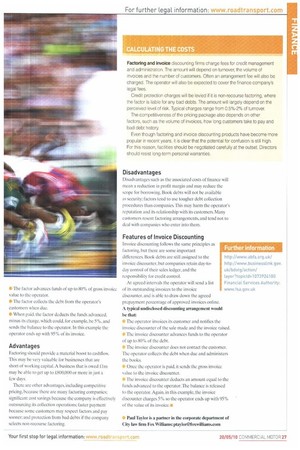Operators may consider factoring o invoice discounting as a means
Page 26

Page 27

If you've noticed an error in this article please click here to report it so we can fix it.
to speed up cash flow. What are the advantages and disadvantages?
Often the terms factoring' and 'invoice discounting' are used interchangeably, but they are two quite separate things. So what are they and how can they help you and your business?
With factoring, the factor (finance company) assumes responsibility for collecting the debts and administering the operator's sales ledger. With invoice discounting, the operator retains responsibility for collecting the debts, administering the sales ledger and for accounting to the finance company.
Both factoring and invoice discounting are valuable tools for freeing up working capital from a company's outstanding book debts. By factoring or discounting debts, working capital can be obtained almost immediately. As well as providing finance, both can offer valuable support services and sometimes credit insurance.
Factoring and invoice discounting do not lend money. Instead, they take a legal assipment of the book debts in exchange for which they make available a pre-payment facility. This allows operators to access funds quickly — usually within 48 hours of raising invoices— rather than having to wait for their debtors to pay.
Most facilities are "with recourse';which means that the operator bears the risk of non-payment. -Non-recourse" facilities place the risk with the finance company, but cost the operator more because they are usually guaranteed by insurance that is paid for by the operator.
Features of factoring
A factoring company will typically take over the day-today running of a company's sales ledger. This will involve carrying out credit checks on debtors, sending out statements, telephone credit control, collecting payments and taking legal action, if required.
A typical factoring process consists of:
The operator invoices its customer and sends a copy of the invoice to the factor. Invoices will typically have a clause informing the customer of the factoring arrangement.
• The factor advances funds of up to 80% of gross invoice value to the operator.
• The factor collects the debt from the operator's customers when due.
• When paid. the factor deducts the funds advanced. minus its charge, which could, for example, be 5%, and sends the balance to the operator. In this example the operator ends up with 95% of its invoice.
Advantages
Factoring should provide a material boost to cashflow. This may be very valuable for businesses that are short of working capital. A business that is owed £lin may be able to get up to 1800,000 or more in just a few days.
There are other advantages, including competitive pricing, because there are many factoring companies; significant cost savings because the company is effectively outsourcing its collection operations; faster payment because some customers may respect factors and pay sooner: and protection from bad debts if the company selects non-recourse factoring.
Disadvantages Disadvantages such as the associated costs of finance will mean a reduction in profit margin and may reduce the scope for borrowing. Book debts will not be available as security: factors tend to use tougher debt collection procedures than companies. This may harm the operator's reputation and its relationship with its customers. Many customers resent factoring arrangements, and tend not to deal with companies who enter into them.
Features of Invoice Discounting Invoice discounting follows the same principles as factoring, but there are some important differences. Book debts are still assigned to the invoice discounter, but companies retain day-today control of their sales ledger, and the responsibility for credit control.
At agreed intervals the operator will send a list of its outstanding invoices to the invoice discounter, and is able to draw down the agreed prepayment percentage of approved invoices online. A typical undisclosed discounting arrangement would he that: The operator invoices its customer and notifies the invoice discounter of the sale made and the invoice raised.
The invoice discounter advances funds to the operator of up to 80% of the debt.
k The invoice discounter does not contact the customer. The operator collects the debt when due and administers the books.
Once the operator is paid, it sends the gross invoice value to the invoice discounter.
* The invoice discounter deducts an amount equal to the funds advanced to the operator. The balance is released to the operator. Again, in this example, the invoice discounter charges 5% so the operator ends up with 95% of the value of its invoice. u
Paul Taylor is a partner in the corporate department of City law firm Fox Williams: ptaylor@foxwilliams.com








































































































































































